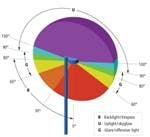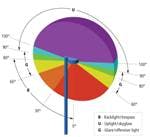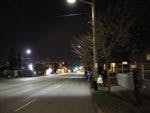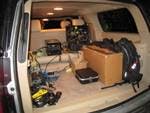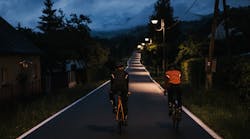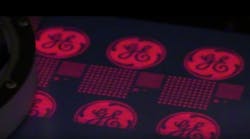This article was published in the April/May 2012 issue of LEDs Magazine.
View the Table of Contents and download the PDF file of the complete April/May 2012 issue, or view the E-zine version in your browser.
+++++
In Seattle, WA, the Virginia Tech Transportation Institute (VTTI) and lighting consultancy Clanton & Associates recently led a LED street light symposium and conducted three nights of solid-state lighting (SSL) roadway tests focused on the balance of dimming lights and safety. The symposium included lessons learned from LED lighting case studies, a review of previous VTTI tests of light levels and safe object/pedestrian detection distances, and an explanation of the goals of the Seattle testing. Participants in the testing program provided both qualitative and quantitative data to the project team that will build on a growing knowledge base focused on energy efficiency and safety.
The symposium kicked off with a brief presentation from Mark Rehley, emerging technology operations manager at NEEA. Rehley said that the goal of the Seattle test was to help establish national and regional standards that dictate “What’s the right amount of light to put on the roadway.”
The issue of course is that lower light levels equate to less energy used and that’s important even in the case of inherently-efficient LED lighting. “We think that SSL alone is not the answer,” said Rehley. “The biggest value comes when you combine [SSL] with advanced controls. The advanced controls provide the value of being able to turn the lights on and off at very precise periods instead of relying on a photo sensor that gets dirty… and perhaps fails more readily than the SSL.”
Rehley also discussed the added implications of smart street lights making the analogy of having a smartphone and apps on light poles. He suggested that networked street lights in the future will strobe to guide emergency workers to an accident. And he said such lights could indicate detour routes in the case of a natural disaster.
Questioning conventional wisdom
Nancy Clanton, president of Clanton & Associates, took the podium to start the technical presentations and immediately issued a challenge to the audience. About street lighting she asked, “Are we doing it the right way?” And specifically she was referring to deploying street lights with LEDs as a revolutionary light source.
“We take this LED light and stick it on a pole because that’s how we have always done street lighting.” said Clanton. “LEDs are great at grazing. Maybe we should have more layered lighting like we do in interior design with an ambient and a task.”
Clanton suggested that just putting light down on a road isn’t sufficient. She said effective lighting requires contrast of surfaces along with the ability to optimize color contrast. Indeed she was foreshadowing some of the concepts that VTTI is researching through LED street light tests.
Clanton, however, explored a more subtle concept with controllable LED lighting that could have a big impact in slashing power usage. She said that in the case of legacy sources such as high-pressure sodium (HPS) lamps, there is little chance to select the light level needed for an application. If a 150W HPS lamp falls just short of meeting the requisite level for a given application, the only recourse has always been to go to a 250W lamp. But with LEDs you can step up to the brighter source but dim it down to where it just meets the required level and pocket the energy savings.
Beam patterns and BUG
Control of the beam pattern both saves energy by efficiently using the produced light and eliminating light pollution. Clanton was very involved in developing the Model Lighting Ordinance (MLO) that’s being recommended for area lighting, and has been involved with ways to specify beam control for roadway lighting working with the Illuminating Engineering Society of North America (IESNA).
Ironically, perhaps, Clanton said that some LED fixtures control light too rigidly. She is a dark sky advocate and was not suggesting any tolerance for light pollution. But she said many people prefer a “fuzzy cutoff.” Fig. 2 provides an example of the concept. Clanton defined the example as well-designed lighting because it does illuminate the sidewalk although it only allows backlight on the base of the building. That performance is superior according to Clanton to either a light that only illuminates the street, or one that casts a lot of backlight on the building.
Seattle LED installations
A presentation of several LED street light case studies was among the most information-packed elements of the symposium. Edward Smalley presented Seattle’s experience to date with LEDs. Smalley works for Seattle City Light, although he has spent the bulk of his time in the past two years on his duties as director of the US Department of Energy (DOE) Municipal Solid-State Street Lighting Consortium. But Smalley led Seattle’s foray into LEDs.
The cost issues led the city to consider LEDs, and a chief concern was cost of the luminaires. Smalley said he was asked in 2008, “What will it take for Seattle to pull the trigger on LED street lights?” implying a major deployment. Smalley said at the time the luminaire they were considering for residential streets was selling for more than $400. He said $350 was their target trigger point.
Fast forward to today, and Seattle has converted somewhere between 18,000 and 21,000 lights – they have products in inventory to reach the higher number. They have realized $1 million per year in savings. The expenditures to date are in the $8 million range. Smalley said the projected payback is 7.6 years.
The economic picture gets even brighter looking forward. Smalley said that Seattle is paying around $240 per luminaire today. He said, “Prices are going to drop and that’s a good thing.” He attributed the expected declines to the semiconductor industry that is behind both LED components and the driver electronics. Smalley projects that the price will ultimately bottom out in the $175 range.
Colorado Springs LED experience
The experience of Colorado Springs, CO with LEDs is at a much earlier level than Seattle, but the lessons learned there may be equally valuable. City traffic engineer David Krauth described the dilemma the city faced three years ago with municipal budget cuts and the cost of operating street lights. Krauth said, “Our answer was we’re going to turn off one third of the lights.”
Krauth said when he started work for the city, 400W HPS lights were common on arterials and that the city also had a number of high-mast lights that had six 1000W lamps per pole. He said turning three poles off saved $16,000 per year.
Krauth detailed some of the common issues with over-lighting a city. He said “One bright spot begats a bigger bright spot.” After people go through an over-lit area, Krauth said a correctly-lit area appears to be under lit. That inconsistency can lead a municipality to brighter and brighter lights.
In Colorado Springs after the selected lights were extinguished, Krauth said the city received over 1000 complaint calls. But the complaints weren’t just about safe lighting on streets. Krauth said, “It’s amazing the number of people that want their backyards lit by street lights, and the number of people that don’t.” That was a recurring theme at the symposium in that some citizens like light spill onto their property. It led Frauth to rhetorically ask, “How do you run a system that does both?”
The city has installed around 500 LED street lights including a mix of cobrahead- and acorn-style fixtures. But the city is struggling with consistency even with the LED lights. Krauth said that in the case of the acorn fixtures, the city maintained the same pole spacing that it has used with HPS lights, but the LEDs are brighter. He said, “We have one street that goes into the airport that I’m amazed an airplane hasn’t landed on it yet. It is bright.” Krauth is planning a new set of consistent standards developed from the ground up.
Ultimately the move to LEDs is focused on operating cost. Krauth said the city wants to “make sure we can pay for the system and keep operating it.” He did point out a surprising place where SSL is adding to the savings. He said the city had 450 lights incapacitated by copper wire theft totaling almost a quarter million feet of wire. He said lower-power LED fixtures do allow for smaller, lower-cost wire.
Ballard test site
At the end of the symposium, the bulk of the attendees made their way to the test site in the Ballard area, where some brief presentations (www.ledsmagazine.com/news/9/3/4), including one by Seattle mayor Mike McGinn, were followed by a walking tour of the test site. The symposium attendees went through the qualitative lighting evaluation process just as public volunteers would over the course of three nights.
The final segment used a custom asymmetrical beam pattern that directed all light in the direction of traffic with no glare in evidence for drivers (Fig. 4). The roadway is three lanes in each direction with a center turn lane. The lights for the southbound lanes only projected light south, and vice versa for the northbound lanes.
The survey was primarily based on 12 statements for which the respondents had to choose among five choices ranging from strongly disagree to strongly agree. Examples include “there is too much light on the street, “ “the light sources are glaring,” and “I like the color of the light.” There are also numerous questions involving how safe a respondent feels walking in the area. Down the road, we will see those results tabulated.
Evaluating the lights
Here, I will summarize my own observations of the lighting. Upon first impression, the 400W HPS sources provided far better pedestrian visibility than any of the other lights tested. But without question that test area was over lit. Consider Fig. 5. Those side-by side images are of completely different buildings yet you can easily see the differences in backlight. In the HPS example on the right, there is substantial light on the wall and window on the second floor of the house on the far right. In the image on the left with LED lighting there is virtually no light cast on the walls of the one-story building, yet you can see that the sidewalk is lit.
While the 400W HPS sources produced what seem to be more than plentiful light, the lights did not render colors well. Watching other participants in the walking tour with various colors of clothing, you could see how color contrast might come into play allowing better object detection even at lower light levels.
I was very surprised that I couldn’t really discern the differences in CCT with the three sets of LEDs that used a standard beam pattern. Those three lights generated uniform light levels on the roadway and sidewalk, and also rendered colors very well.
The road segment with an asymmetric pattern was immediately recognizable. You could see that the light on the roadway got dimmer farther from the pole. And there was no light from the next pole helping to fill in and make the light level appear uniform. Essentially you could see periodic dark sections on the road. Ultimately, that may or may not be a problem, as it could enable superior contrast – that’s among the reasons the team chose to test the asymmetric fixture.
We were also afforded the opportunity to view the LED lights dimmed to 50% and 25% of full light output. One of the project team members used an iPad to change the light levels of individual luminaires and groups of luminaires. While you could see the dimming happening by focusing on the light projected on the road, it was difficult to discern any difference in visibility once the luminaires were stable at 50%. There was noticeably less light at 25%, although I’m not sure I would have felt unsafe walking in that light.
Quantitative tests
Ultimately it’s the quantitative testing that will determine how well drivers might see objects or pedestrians under the lights including tests conducted at the 25% and 50% dim levels for the LEDs. We won’t see that data for several month. But I did have a chance to participate in one of the tests.
VTTI equipped an SUV with a data acquisition system used for the tests (Fig. 6). That system links to a number of light sensors, cameras, a GPS receiver for precise location, and a push button that test subjects use to signal when they spot an object. The VTTI team located 7x7-in objects of various colors along the test site. And VTTI drivers navigated the roadway at a constant 35 MPH while test subjects looked for the objects and responded with the push button with the GPS logging the location of each depression of the button.
I asked Ron Gibbons of VTTI how the system accurately detected an instance of two button pushes when the test subject may have seen the further object first. Gibbons said the forward-looking mono and binocular cameras mounted in the SUV mimic the human visual system and would see the objects in similar order to testers. Evidently the system uses that camera data to correlate the data generated by the volunteers.
What will come out of the test is likely to be similar to the results we have seen from Gibbons and his team before. Gibbons uses the reference source and compares the other test sources in terms of object detection distance. In prior tests, for example, LEDs have provided detection distance 66-78% as great as the reference source while generating only 9-18% of the illuminance, and of course the LEDs use far less energy.
During the symposium, Gibbons said, “Lighting level has very little to do with detection.” Gibbons said the human body responds to sensory things like lighting on a logarithmic scale. He added, “”Foot candles are meaningless. It’s all about detection distance.”
We will cover the results once released and the finding will surely be interesting. Gibbons said in similar previous tests, the team had not been able to reduce the light level of the LEDs low enough to render the tested lights unsuitable in terms of detection distance. We will see if the 25% level in Seattle does so, and what impact the asymmetric pattern may have had on detection distance.
